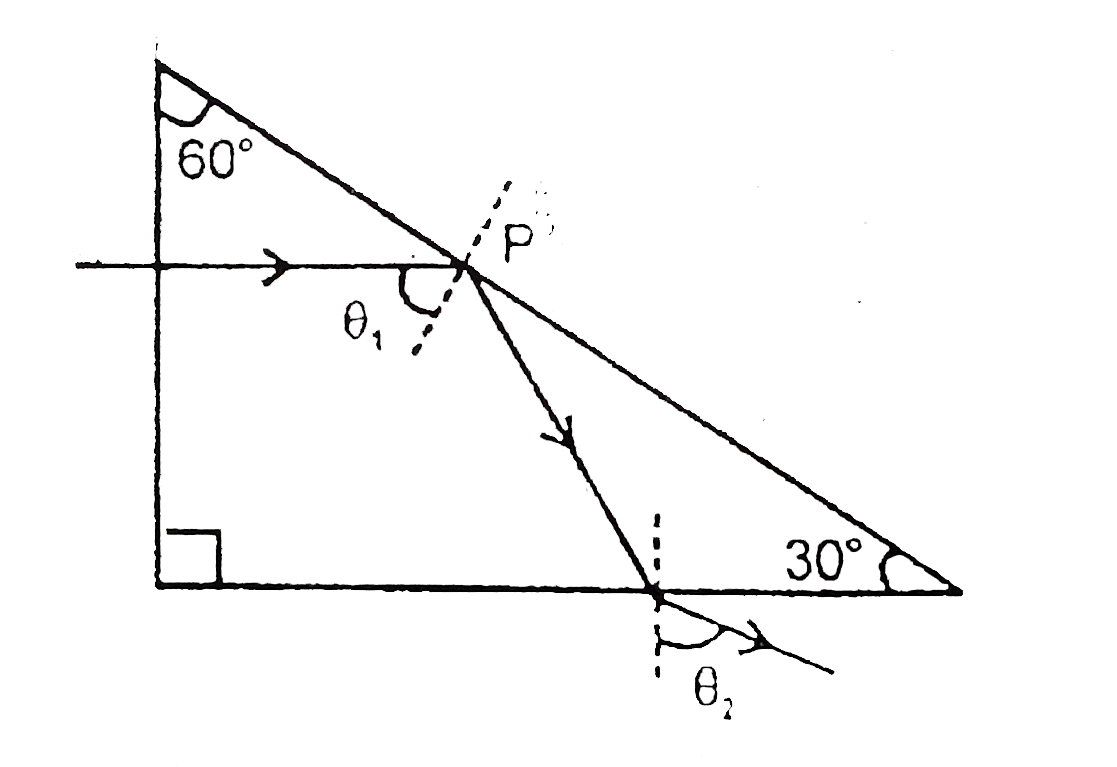A ray of light incident at an angle θ on a refracting face of a prism emerges from the other face normally. If the angle of the prism is 5∘ and the prism is made of a material of refractive index 1.5, the angle of incidence is.
7.5∘
5∘
15∘
2.5∘
The correct Answer is:A
To solve the problem, we need to find the angle of incidence (θ) for a ray of light incident on a prism with a given angle and refractive index. Here are the steps to derive the solution:
1. Identify Given Values:
- Angle of the prism (A) = 5°
- Refractive index (μ) = 1.5
2. Use the Formula for Angle of Deviation (δ):
The angle of deviation (δ) can be calculated using the formula:
δ=(μ−1)×A
Substituting the values:
δ=(1.5−1)×5°=0.5×5°=2.5°
3. Understand the Emergence Condition:
The ray emerges normally from the second face of the prism, which means the angle of refraction (r2) at the second face is 0°.
4. Apply the Prism Formula:
The relationship between the angles of the prism and the angles of incidence and refraction is given by:
A=r1+r2
Since r2=0°, we have:
A=r1+0°⟹r1=A=5°
5. Use Snell's Law:
According to Snell's law:
sini1sinr1=μ
Since r1=5°, we can write:
sini1=μ⋅sinr1
Substituting the values:
sini1=1.5⋅sin(5°)
6. Calculate sin(5°):
Using a calculator or trigonometric tables:
sin(5°)≈0.0872
Therefore:
sini1=1.5⋅0.0872≈0.1308
7. Find i1:
To find the angle of incidence i1, we take the inverse sine:
i1=sin−1(0.1308)≈7.5°
Final Answer:
The angle of incidence i1 is approximately 7.5°.
---
- Angle of the prism (A) = 5°
- Refractive index (μ) = 1.5
The angle of deviation (δ) can be calculated using the formula:
δ=(μ−1)×A
Substituting the values:
δ=(1.5−1)×5°=0.5×5°=2.5°
The ray emerges normally from the second face of the prism, which means the angle of refraction (r2) at the second face is 0°.
The relationship between the angles of the prism and the angles of incidence and refraction is given by:
A=r1+r2
Since r2=0°, we have:
A=r1+0°⟹r1=A=5°
According to Snell's law:
sini1sinr1=μ
Since r1=5°, we can write:
sini1=μ⋅sinr1
Substituting the values:
sini1=1.5⋅sin(5°)
Using a calculator or trigonometric tables:
sin(5°)≈0.0872
Therefore:
sini1=1.5⋅0.0872≈0.1308
To find the angle of incidence i1, we take the inverse sine:
i1=sin−1(0.1308)≈7.5°
The angle of incidence i1 is approximately 7.5°.
Topper's Solved these Questions
- RAY OPTICSBOOK - DC PANDEY ENGLISHCHAPTER - RAY OPTICSEXERCISE - medical entrance special format question
23 Videos
- RAY OPTICSBOOK - DC PANDEY ENGLISHCHAPTER - RAY OPTICSEXERCISE - Medical entrance gallary
76 Videos
- RAY OPTICSBOOK - DC PANDEY ENGLISHCHAPTER - RAY OPTICSEXERCISE - Checkpoint 9.7
10 Videos
- NUCLEIBOOK - DC PANDEY ENGLISHCHAPTER - NUCLEIEXERCISE - C MADICAL ENTRANCES GALLERY
46 Videos
- REFLECTION OF LIGHTBOOK - DC PANDEY ENGLISHCHAPTER - REFLECTION OF LIGHTEXERCISE - Subjective
9 Videos
Similar Questions
Find the angle of minimum deviation for an equilateral prism made of a material of refractive index 1.732. What is the angle of incidence for this deviation ?
View Solution
A ray of light is incident normally on one face of a prism as shown in figure. The refractive index of the material of the prism is 53 and the prism is immersed in water of refractive index 43, then
View Solution
Knowledge Check
A ray of light is incident at small angle I on the surface of prism of small angle A and emerges normally from the oppsite surface. If the refractive index of the material of the prism is mu, the angle of incidence is nearly equal to
AAμBA2μCμADμA2
When a ray of light is incident normally on one refracting surface of an equilateral prism (Refractive index of the material of the prism =1.5
View SolutionWhen a ray of light is incident normally on one refracting surface of an equilateral prism (Refractive index of the material of the prism =1.5)
View SolutionA ray of light is incident at small angle I on the surface of prism of small angle A and emerges normally from the oppsite surface. If the refractive index of the material of the prism is mu, the angle of incidence is nearly equal to
View SolutionA ray of light is incident at small angle I on the surface of prism of small angle A and emerges normally from the oppsite surface. If the refractive index of the material of the prism is mu, the angle of incidence is nearly equal to
View SolutionA ray of light incident at an angle 90° with the face of an equilateral prism passes symmetrically. Calculate the refractive index of the material of the prism
View SolutionA ray of light falls on a normally on a refracting face of a prism. Find the angle of prism if the ray just fails to emerge from the prism (μ=3/2).
View SolutionA light ray is incident normally on one of the refracting faces of a prism and just emerges out grazing the second surface. Then, the relation between angle of the prism and its critical angle is
View Solution